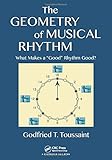The geometry of musical rhythm [Book] : what makes a "good" rhythm good? / Godfried T. Toussaint ; illustrative drawings by Yang Liu.
Material type: TextPublication details: Boca Raton, FL : CRC Press, Taylor & Francis Group, c2013.Description: xvii, 347 p. : ill. ; 26 cmISBN:
TextPublication details: Boca Raton, FL : CRC Press, Taylor & Francis Group, c2013.Description: xvii, 347 p. : ill. ; 26 cmISBN: - 1466512024 (Paperback)
- 9781466512023 (Paperback)
- 781.224 23
- 781.224
| Item type | Current library | Call number | Status | Date due | Barcode | Item holds |
|---|---|---|---|---|---|---|
 Books
Books
|
Junaid Zaidi Library, COMSATS University Islamabad Ground Floor | 781.224 TOU-G (Browse shelf(Opens below)) | Available | 47338 |
"A Chapman & Hall book."
The Geometry of Musical Rhythm: What Makes a "Good" Rhythm Good? is the first book to provide a systematic and accessible computational geometric analysis of the musical rhythms of the world. It explains how the study of the mathematical properties of musical rhythm generates common mathematical problems that arise in a variety of seemingly disparate fields. For the music community, the book also introduces the distance approach to phylogenetic analysis and illustrates its application to the study of musical rhythm. Accessible to both academics and musicians, the text requires a minimal set of prerequisites. Emphasizing a visual geometric treatment of musical rhythm and its underlying structures, the author—an eminent computer scientist and music theory researcher—presents new symbolic geometric approaches and often compares them to existing methods. He shows how distance geometry and phylogenetic analysis can be used in comparative musicology, ethnomusicology, and evolutionary musicology research. The book also strengthens the bridge between these disciplines and mathematical music theory. Many concepts are illustrated with examples using a group of six distinguished rhythms that feature prominently in world music, including the clave son. Exploring the mathematical properties of good rhythms, this book offers an original computational geometric approach for analyzing musical rhythm and its underlying structures. With numerous figures to complement the explanations, it is suitable for a wide audience, from musicians, composers, and electronic music programmers to music theorists and psychologists to computer scientists and mathematicians. It can also be used in an undergraduate course on music technology, music and computers, or music and mathematics.


There are no comments on this title.